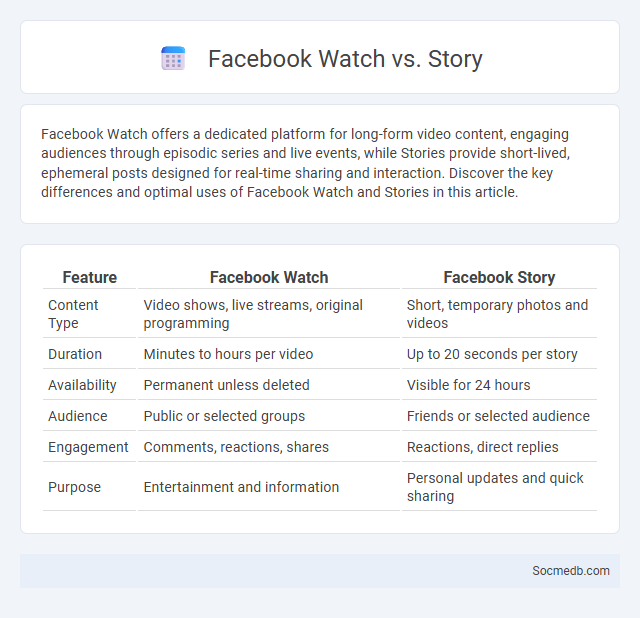
Photo illustration: Facebook Watch vs Story
Facebook Watch offers a dedicated platform for long-form video content, engaging audiences through episodic series and live events, while Stories provide short-lived, ephemeral posts designed for real-time sharing and interaction. Discover the key differences and optimal uses of Facebook Watch and Stories in this article.
Table of Comparison
| Feature | Facebook Watch | Facebook Story |
|---|---|---|
| Content Type | Video shows, live streams, original programming | Short, temporary photos and videos |
| Duration | Minutes to hours per video | Up to 20 seconds per story |
| Availability | Permanent unless deleted | Visible for 24 hours |
| Audience | Public or selected groups | Friends or selected audience |
| Engagement | Comments, reactions, shares | Reactions, direct replies |
| Purpose | Entertainment and information | Personal updates and quick sharing |
Introduction to Facebook Watch and Stories
Facebook Watch offers a dynamic platform for video content, integrating personalized recommendations and community engagement to keep users entertained. Stories on Facebook provide a quick, immersive way to share photos and videos that disappear after 24 hours, boosting real-time interaction and authentic connections. Combining these features enhances user experience by blending long-form video consumption with ephemeral, social sharing.
Key Differences Between Facebook Watch and Stories
Facebook Watch offers a long-form video platform focused on original shows, live events, and user-generated content, supporting extended viewing experiences up to hours in length. Stories on Facebook are short, ephemeral clips or images lasting up to 20 seconds each, designed for quick, casual sharing that disappears after 24 hours. The key distinction lies in Watch's emphasis on curated, discoverable video content versus Stories' transient, personal updates intended for rapid engagement.
Content Formats: Video vs. Photo vs. Mixed Media
Choosing the right content format for your social media strategy impacts engagement and reach significantly. Videos capture attention through dynamic storytelling and higher retention rates, while photos offer quick, visually appealing messages that are easily shareable. Mixed media combines the strengths of both, allowing your brand to create diverse, compelling content that caters to different audience preferences and boosts overall interaction.
Audience Engagement: Watch vs. Stories
Audience engagement on social media varies significantly between Watch and Stories formats, with Watch videos fostering deeper viewer immersion through longer, on-demand content that encourages comments and shares. Stories generate high interaction rates via ephemeral, bite-sized updates prompting immediate reactions, polls, and direct messages. Marketers leveraging these platforms optimize reach by aligning content length and interactivity with viewer preferences and platform algorithms.
Algorithm and Content Discovery
Social media platforms rely heavily on sophisticated algorithms to personalize content discovery, analyzing user behavior, preferences, and engagement patterns to curate relevant feeds. These algorithms prioritize content based on factors such as recency, interaction frequency, and content type relevance, enhancing user retention and platform engagement. Continuous updates to algorithmic frameworks optimize content visibility and ensure diversified discovery across multimedia formats and trending topics.
Monetization Opportunities for Creators
Social media platforms offer diverse monetization opportunities for creators, including brand partnerships, affiliate marketing, and ad revenue sharing. Tools like YouTube's Partner Program and Instagram's Shopping feature enable direct income through content engagement and product promotion. Exclusive content subscriptions and crowdfunding through platforms like Patreon further expand financial avenues for creators.
Analytics and Performance Insights
Social media analytics provide granular insights into audience behavior, engagement rates, and content performance, enabling brands to refine strategies for maximum impact. Advanced performance insights utilize metrics such as click-through rates, conversion tracking, and sentiment analysis to optimize campaigns and measure ROI effectively. Leveraging these data-driven tools enhances targeting accuracy and drives higher engagement across platforms like Instagram, Facebook, and Twitter.
Advertising Options and Brand Integration
Social media platforms offer diverse advertising options such as sponsored posts, influencer partnerships, and targeted ads that enable precise audience reach. Brand integration through native content and product placements within user feeds enhances engagement and builds authentic connections. Your marketing strategy can leverage these tools to increase brand visibility and drive customer interaction effectively.
User Experience and Accessibility
Social media platforms prioritize user experience by offering intuitive interfaces, fast loading times, and personalized content algorithms to keep engagement high. Accessibility features such as screen reader compatibility, voice commands, adjustable text sizes, and high-contrast modes ensure inclusivity for users with disabilities. Incorporating these elements improves overall usability, making social media more welcoming and efficient for diverse audiences worldwide.
Choosing the Right Format for Your Content Strategy
Selecting the right format for your social media content strategy significantly impacts your engagement and reach. Visual content like videos and infographics often outperforms text-only posts by capturing attention quickly and conveying messages more effectively. Tailoring your format to match your audience's preferences increases the likelihood that your followers will interact with Your content and share it across platforms.
 socmedb.com
socmedb.com